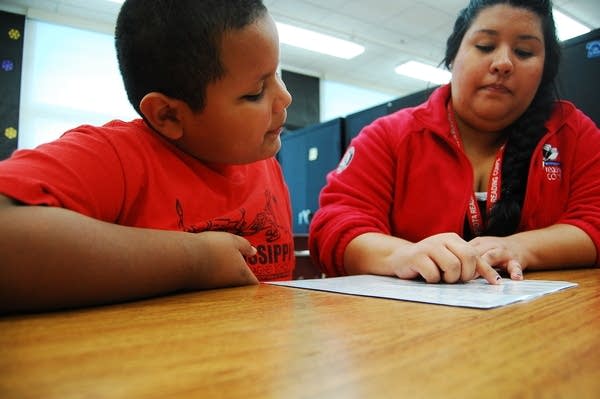Minn. students' reading scores stuck in place as ranking slips nationally
Go Deeper.
Create an account or log in to save stories.
Like this?
Thanks for liking this story! We have added it to a list of your favorite stories.

Test scores from the National Assessment of Education Progress show that Minnesota students made little progress over the last decade in reading.
To address such results, Minnesota should focus on making sure that students can read by the time they leave the third grade, state Education Commissioner Brenda Cassellius said.
Although Minnesota students continue to beat the national average in reading, the scores of students in the fourth and eighth grades show no improvement and the state continues to slide in national rankings.
While students in other states have improved their reading performance, Minnesota's students appear to be inching toward the middle of the pack, with scores that haven't moved much in the past decade. In 1998, only nine states had a higher average reading score than Minnesota. This year, 18 states scored higher.
Turn Up Your Support
MPR News helps you turn down the noise and build shared understanding. Turn up your support for this public resource and keep trusted journalism accessible to all.
That's not a total surprise, as student performance on the Minnesota Comprehensive Assessment test recently showed similar results.
"We are really worried about these reading scores and we knew we needed to address this," Cassellius said. "We're going to go with what works, which is focusing on getting students high quality, early childhood learning opportunities — we know that's gap closing."
Cassellius is referring he statistical gap in performance on standardized tests that exists between minority students and their white counterparts, and between affluent students and those from homes that fall below the poverty level.
In the fourth grade, for example, the average score for white students in Minnesota was 255 out of 500. Hispanic students had an average score of 230 and black students, 225. All are better than the national average of 220.
The new scores are the latest to show that Minnesota has one of the worst achievement gaps in the nation, one that is growing in some areas. In fourth grade reading, for example, the average score for white students was 30 points higher than for blacks.
Not every Minnesota student takes the national test, but enough do to provide the needed sample to compare Minnesota's scores with other states. Such a comparison is a rarity in the testing world because many states use their own unique tests.
Fourth and eighth graders take the test in reading and math every two years. In math, Minnesota students are still among the best. Only Massachusetts had a higher average score than Minnesota in eighth grade math, for example.
State education officials say that to improve reading scores and eliminate the disparities in performance Minnesota must focus on third-grade reading. Researchers say reaching students in the third grade is critical because before then teachers prepare children to read. After third grade, students use their reading skills to learn.
Among the Minnesota schools to intensely focus on teaching reading in the third grade is Mississippi Magnet in St. Paul, where 92 percent of students are from impoverished homes. Only a quarter of the students speak English as their first language. Still, the school's reading scores rose 6 percent this year.
Part of the credit goes to the extra, one-on-one help students like third-grader Francisco Jaramillo, 8, receives from tutor Maria Rios.
"I'll have him read the paragraph first by himself," Rios said. "And then after that, we take turns reading every other word where I start, so we're making sure he's reading every word — and he's listening to me read every other word."
Born in Mexico, Rios, 23, is a former Mississippi Magnet student who graduated from the University of Minnesota this spring. She is spending a year with the AmeriCorps program. About 800 AmeriCorps members are in what's called the Minnesota Reading Corps this year.
Francisco, who wasn't reading at grade level when he was tested at the beginning of the year, will be re-tested monthly and leave the tutoring program when he improves.
"One of the things I like to tell the students is you're a good reader when you know you said something incorrectly and you go back and fix it, compared to others who read it and didn't know they made a mistake and we have to point it out to them," Rios said. "He knows if he's made a mistake or not."
Former state Sen. Kathy Saltzman, who heads the Reading Corps, said the program itself won't help schools improve. But it is part of a bigger picture.
"If children are not reading by third grade," she said, "it's very hard to catch up."
Saltzman said she understands why people might scoff at the idea that tutoring could be the next big thing given that education officials have tried different approaches for three years.
But Saltzman said elected officials, business leaders and private foundations agree that teaching reaching in the third grade is key.
"[We're] all coming together to say we need to be strategic, intentional and focused to make sure every child reads by the end of third grade," she said. "That's such a critical skill for their future success."
Although Minnesota was struggling to overcome a $5 billion deficit, state legislators increased the Reading Corps funding boost this year from less than $3 million to more than $8 million. Lawmakers also added funding for third grade literacy efforts and a new program that will reward schools with extra funds if they meet certain reading benchmarks.
One benchmark for success will come in two years when the next national test scores are released. The students who take that fourth grade test will be the ones who'll have just gone through the state's new focus on third-grade reading skills.



